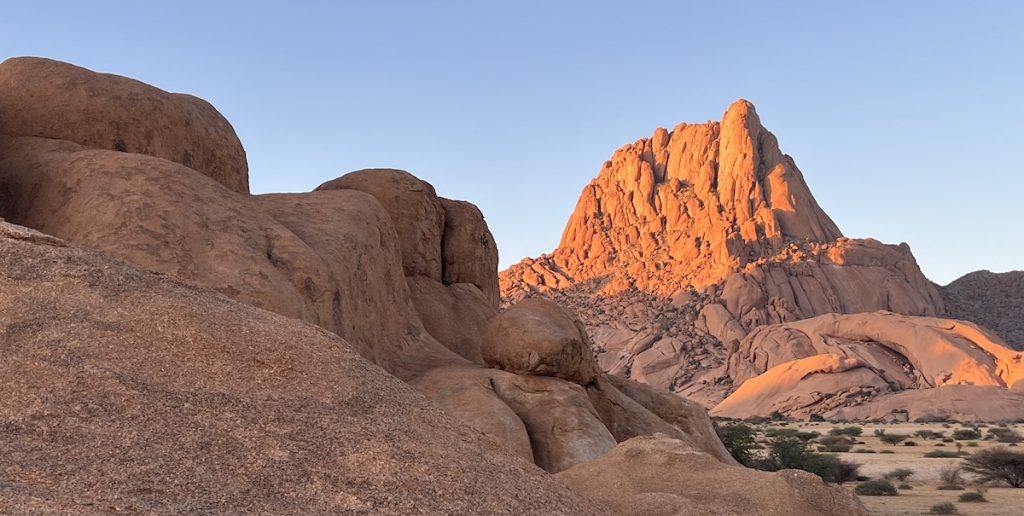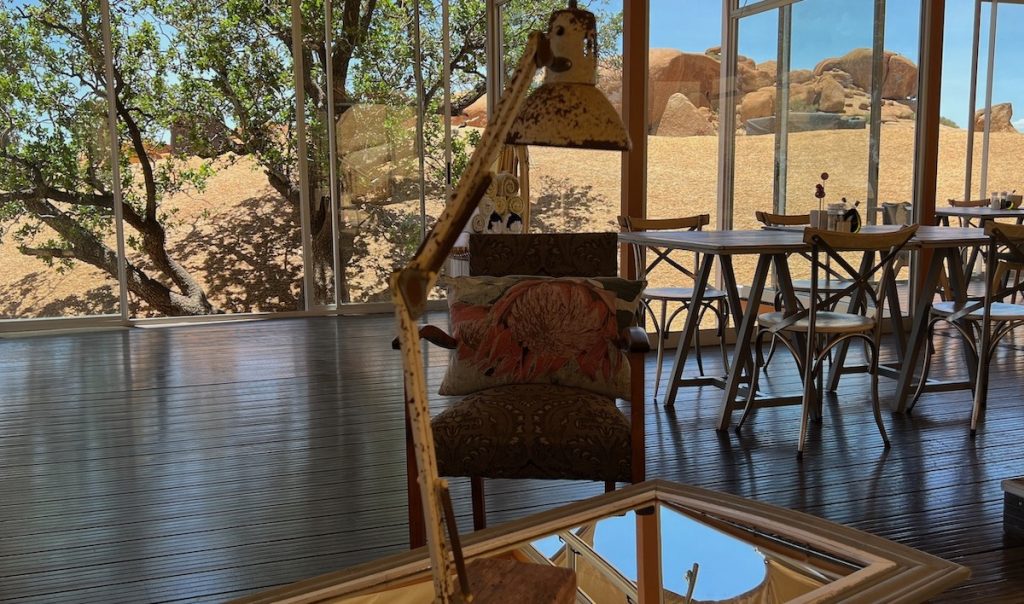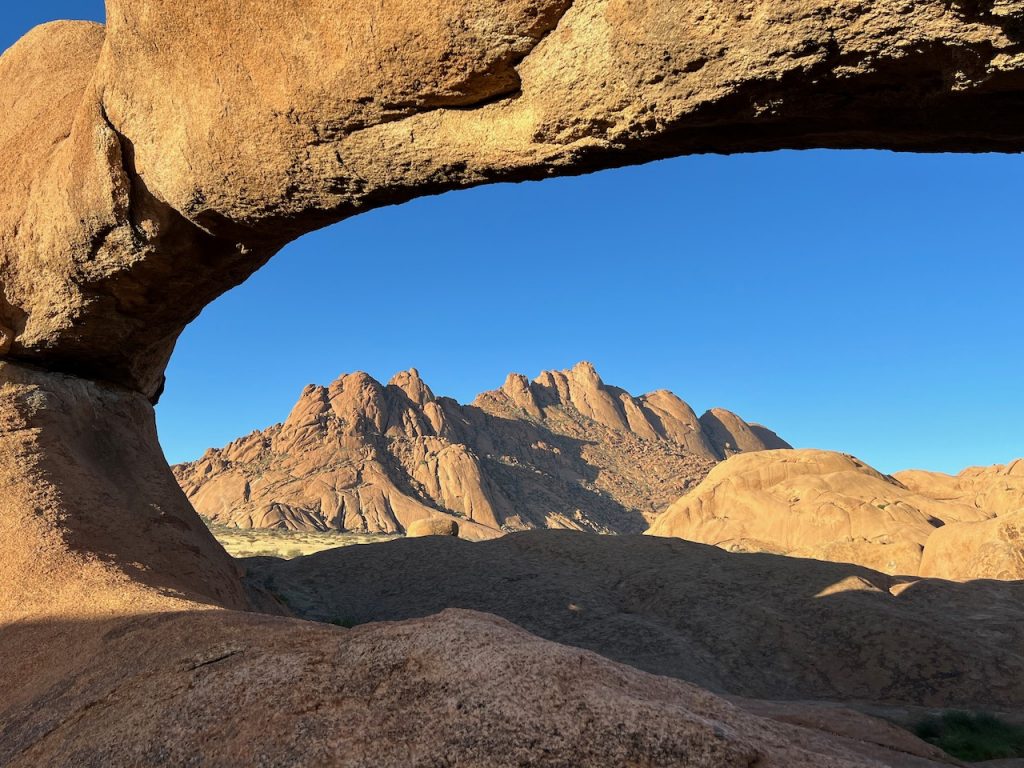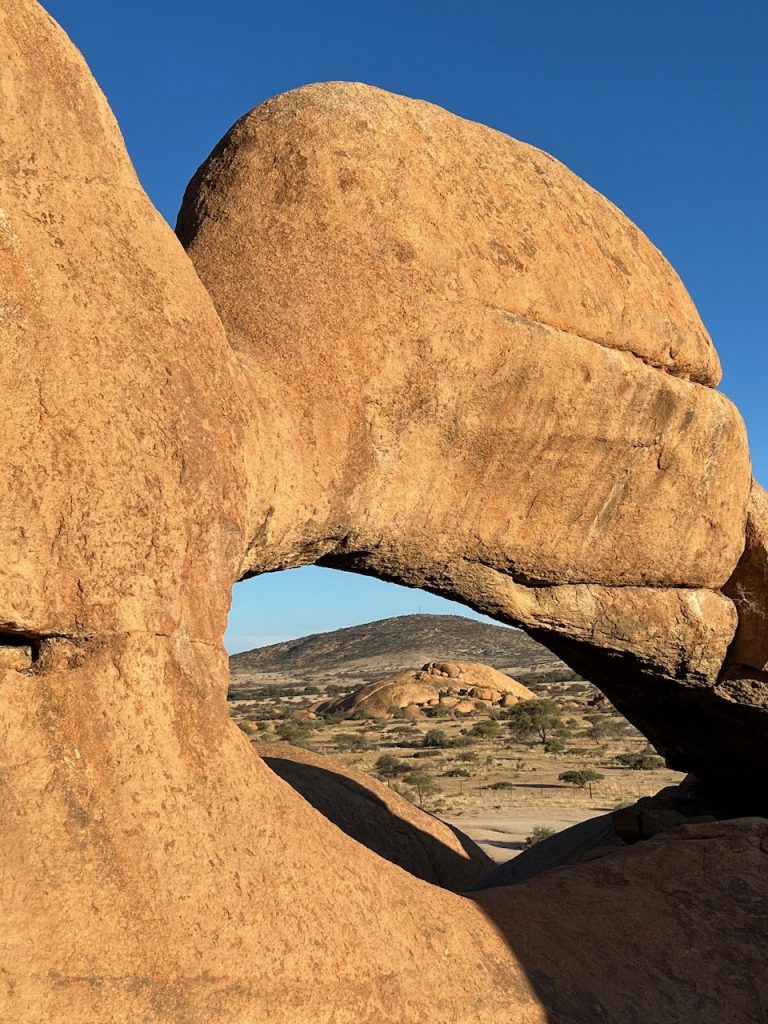The Spitzkoppe is a group of bald granite peaks located between Usakos and Swakopmund in the Namib desert. It is a 1.5 hours drive from Swakopmund, the last 30 km are dirt road. The granite is more than 150 million years old and the highest outcrop rises about 1,728 metres above sea level. The peaks stand out dramatically from the flat surrounding plains.
At the foot of the Spitzkoppe a trading post was built by the Germans in 1896. It was transferred later to a farmer and a police station was built. In 1964, under the so-called Odendaal plan, the farm was expropriated with compensation. Multiple Damara families were replaced here and a small village developed. The Spitzkoppe Community (currently ± 600 people) has since lived in the area, eking out an existence through some livestock farming, small mining of semi-precious stones and craft manufacturing to be sold to tourists.
Places to stay:
Spitzkoppe campsites, Spitzkoppe Mountain Camp and the Spitzkoppen Lodge

Spitzkoppe was recommended to me by two friends, both of them said: “You have to go there!” So I did. I love these surreal moon- or Mars-like landscapes, rough and ancient. Very powerful, a almost mystical place. At Spitzkoppe you find over fourty rock art sites and over 400 paintings from the old San tribe, the original inhabitants of Namibia and Southern Africa. They used to hunt and performed rain-making rituals at Spitzkoppe – as the monochrome reddish brown pigment paintings show us. This well preserved archaeological site provides us insights into the San’s habits over the last 4.000 years.
Of course such a place attracts tourists and it is always a thin fine line how to deal with tourism (I don’t want to use the word sustainable here) in such a fragile and precious environment and how to build in such a landscape without destroying the nature and ambience. This is why I went there – I connected with Ronnie Banard, the owner of the Campsite and the Lodge at Spitzkoppe and in his other life he is an architect, and we talked about these issues. Here is the story.
21 years ago the Namibian government, to be more precise the Ministry of Lands, Resettlement and Rehabilitation, decided to tender the spot. They knew about the potential tourism has to create jobs. A detailed environmental assessment and monitoring of the potential impact of the lodge construction had to be included in the offer. As well as an archaeological survey with the findings I mentioned above. Ronnie followed the procedure and won. It took another 14 years to get everything going, there was quite some back and forth with until finally green light was given.
When I first saw the 15 lodges on the backside of Spitzkoppe, build against a small range of rocks, I was stunned by their airiness and lightness. It’s the contrast which creates unity – in my eyes. Nothing disturbing. Lots of glass and ultralight materials – even the pathways. It just fits into the landscape and can easily be dismantled once the lease expires. This will enable nature to restore itself in just a few months after deconstruction. The space has to be left as it was BEFORE.
The tented roof shapes simulate the surrounding rock formations and soften the square building plan form. While the cottages face east, you can see the sunrise from your bed, the lounge and pool area is facing west – perfect for the sunset. The ‘airy’ construction enables cool air from underneath to filter through the rooms – no aircondition is running. Solar wasn’t an option either, the panels would have had a negative visual impact on the landscape.



The Lodge and the Campsite are run by Ronnie and his wife Elsabe. They’ve created 50 jobs in the area and pay 9% of their cross income to the Conservancy which task is to uplift the area. They have no say in how the money is spent. As far as I know it is ‘normal’ in Namibia – if you are in the tourism industry you have to pay a certain amount back to the constituency you are in.
Their support for the local community goes beyond the jobs and fees. The Lodge and the campsite buy frequently eggs and vegetables from the local businesses if stock is available. Fire wood is also supplied by community members with the request to source outside the Conservation area – which is most likely a bit tricky to proof. Trust is key.
One of Ronnie’s biggest challenges is labour. As part of his contract he has to recruit 80% of the workforce from the surrounding area. It’s not an easy task as there is a lot of unemployment, the villages are scattered, the culture is quite different and the children do not necessarily go to school. If they go, many drop out. So the overall level of quality labour is rather poor – yet he has to manage to match it to the demand and requests of an international high-end tourist clientle. It’s a bit like squarring the circle.
He said: “I expect basic career characteristic such as being honest, respectful and clean and having a solid foundation in the English language.” English is taught at every school. “I don’t expect any knowledge in tourism”, he added. “This is something people can learn!” Ronnie and his team have to focus on capacity building and of changing their employee’s culture. Time for example has not much value in their culture – time doesn’t cost anything and is abundantly available. So why bother? Yet in the service industry time is critical – it does matter if services or products are delivered three days late. Same holds true for cleanliness – a bedsheet or a towel needs to be immaculate when you pay 350 Euros per night as a guest; at home the sheets and towels the people use don’t need to be that accurate. It’s these tiny little things that matter. And it is hard work to get them up to standard. “It helps if you know the people in the area well”, Ronnie explains. “I can tell you if a new employee is coming from a specific family, I know if it will work out or not! If the grandmother and mother are good, it will work. It’s really like that”, he added.
To understand the culture of the people is important for the business. Ronnie knows this. He has done quite some research on the Damara culture to better understand how the people think and tick. “You have to understand where they originate from and how they operated many, many moons ago – only then you can find a midway on which both of us can work on”, he explains. “And it is a thin line to balance the sense of tribal belonging and attitudes with our ‘western’ needs!” And indeed, if you balance right, this combination can be quite charming and winning.
The Namibian government provides a well-defined system to support this work on both sides, the employee and the employer; they are fully aware how important a good functioning business management is for the industry. So every three/four months one of Ronnie’s mangement team members sits down with every employee and they discuss their performances. They have created a four page evaluation catalogue and they go through it page by page. The catalogue includes performance factors which are based on the job description (adminsitration, knowledge of work. communication, team work, decision making/problem solving, independent action – for leaders it is extended by: job knowledge, leadership, managing change and improvement, customer responsiveness, personal appearance, dependability ans employee’s responsiveness), the employee’s strength and accomplishments, areas for improvment, an action plan and the comments of the employee. It is pretty comprehensive.
If the perfomance of the employee is rather faulty and inadequate the management can give – after three complaints – a warning. After the second and final warning they’ve to quit the job. If the performance is good the manger will suggest an increase of the monthly salary depending on how good the performance was. “The system is lengthy and the process is slippy, but it is fair!” says Ronnie.
Ronnie has taken over the Campsite 10 years ago and his Lodge opened in 2016. He is satisfied with what they have achieved so far. After a very bumpy start, the villagers in Spitzkoppe realized, if they clean up their place and keep it clean, if the facilities are no longer filthy but properly taken care of – the tourists will come back and their own lives will become better. The Spitzkoppe people were very proud when they were rated one of the best campsites in Namibia. Having achieved this first turning point in the community, Ronnie was confident that the Lodge will work. “It is still a lot of effort”, he admits, “but for sure all of us are on the right track!”





2 thoughts to “Spitzkoppe – The Matterhorn of Namibia”
do also tell us about the Financials of the place..am invested.. runningvetc
I don’t know about this Mirra, this wasn’t part of what I was writing about …. I focussed on the sensitive area there and what kind of restriction / obligations come along with it. I can connect you with the owner and you can ask him whatever you want to know. I assume – because tehy have a 25 year lease – that the investment will be paid off during this time ….